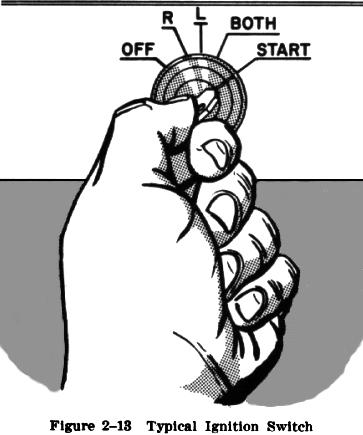Ignition
Ignition System
| The function of the ignition system is to provide an electrical
spark to ignite the fuel/air mixture in the cylinders. The ignition system
of the engine is completely separate from the airplane's electrical system.
The magneto type ignition system is used on most reciprocating aircraft
engines. Magnetos are engine driven self-contained units supplying electrical
current without using an external source of current. However, before they
can produce current the magnetos must be actuated as the engine crankshaft
is rotated by some other means. To accomplish this, the aircraft battery
furnishes electrical power to operate a starter, which through a series
of gears, rotates the engine crankshaft. This in turn actuates the armature
of the magneto to produce the sparks for ignition of the fuel in each cylinder.
After the engine starts, the starter system is disengaged, and the battery
no longer contributes to the actual operation of the engine.
Modern airplane engines are required by Federal Aviation Regulations
to have a dual ignition system - that is, two separate magnetos to supply
the electric current to the two spark plugs contained in each cylinder.
One magneto system supplies the current to one set of plugs; the second
magneto system supplies the current to the other set of plugs. For that
reason the ignition switch |
|
has four positions: OFF, L, R, and BOTH (Fig. 2-13). With the switch in
the "L" or "R" position, only one magneto is supplying current and only
one set of spark plugs in each cylinder is firing. With the switch in the
BOTH position, both magnetos are supplying current and both spark plugs
are firing. The main advantages of the dual ignition system are:
1. Increased safety. In case one system
fails, the engine may be operated on the other until a landing is safely
made. Consequently, it is extremely important for each magneto to be checked
for proper operation before takeoff. This should be done in accordance
with the manufacturer's recommendations. Unless the manufacturer specifies
otherwise, it is advisable to turn the ignition switch from the "BOTH"
position to the farthest "ON" position first, then back to "BOTH;" then
to the nearest "ON" position and back to "BOTH." This sequence best assures
that the magneto switch will be returned to the "BOTH" position for normal
operation. Also, the performance of each ignition system will have been
compared with a "BOTH" performance.
2. More complete and even combustion
of the mixture, and consequently improved engine performance; i.e., the
fuel mixture will be ignited on each side of the combustion chamber and
burn toward the center.
